| This is a featured article. |
- This article is about the titular creatures known as Metroids. For other uses, see Metroid (Disambiguation).
| “ | Metroids are not pets. Metroids are not for target practice. | „ |
Metroids are the titular creatures of the Metroid series. Originating from the planet SR388, they first became known to the universe at large when Space Pirates stole a batch of specimens from a Galactic Federation research vessel and attempted to exploit them as bioweapons. Since then, the species was spread out on numerous planets, endangering all life present due to the Metroids living off of the mysterious "life energy" of their prey.
The Metroids were long rumored to be created by an ancient race, though their motive for doing so remained a mystery to the rest of the universe. Eventually, it came to light that the Chozo, specifically those of the Thoha tribe, were responsible for genetically engineering the species, in order to prevent the spread of the more dangerous X Parasites. Appropriately, the word "Metroid" in the Chozo language roughly translates to "Ultimate Warrior".
The species became extinct in the wild at the end of Super Metroid. Afterwards, the DNA of the last and now-deceased Metroid from SR388 was used to create all subsequent Metroids in the series as well as a vaccine to save Samus Aran from an X Parasite infection, though the treatment genetically altered her into a Metroid hybrid. As of Metroid Dread, Samus is the only individual in the universe who possesses Metroid DNA[1], making her the last living remnant of their kind.
Biology and characteristics[]
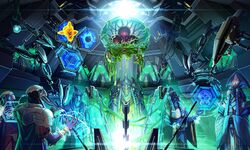
The creation of the Metroids by the Thoha Chozo tribe.
The Metroids on SR388 have diverse shapes and sizes, a result of their complex life cycle that drastically alters their physiology as they grow. They are born as jellyfish-like creatures, eventually molting into a form akin to an arthropod, and as adults they develop features of a theropod; various Metroid husks are discarded throughout the entire process.
Despite their various forms, there is a specific physical feature shared by all Metroids inhabiting SR388: the presence of a translucent, protective membrane enclosing a red nucleus. The nucleus has numerous neuron-like connections extending from it which connect to the inner surface of the membrane. Its function is unknown, but it is of vital importance to the Metroid, as destroying this structure kills the organism. An even greater mystery of their biology is their capacity to perpetually float in midair, as seen in younger individuals, despite lacking any visible means of propulsion.
All Metroids on the planet are incapable of producing offspring with the exception of a single individual, the Queen. Her sole purpose is to increase the population of her species, and while this may insinuate that the Metroids follow a society devoted to their progenitor in a similar fashion to an ant or bee colony, it is seemingly not the case as older members of the species are found scattered across SR388 living independently in order to grow. In fact, only Metroid larvae are seen cohabiting in their birthing site. Interestingly, fully grown adults are located closer to their mother's home in comparison to all other non-larval forms.
| “ | Metroids! This species of energy draining, unicellular aliens can be frozen, then shattered with a blast from one of my missiles, but when they are in their normal, pulsating state, they can absorb my attack. They're treacherous! | „ |
Metroids are highly aggressive creatures with no natural predators and are thus at the top of the food chain on SR388. They feed on life energy from their prey in a manner akin to the way a lamprey or leech drains a host organism's blood. Following a Metroid's attack, however, there is no sign of physical damage - there are no external injuries and the victim's blood and internal organs remain intact, yet lack the energy necessary to sustain life.[2] It is unknown exactly how they extract this life energy or what, in fact, the latter consists of - the Metroid's victim simply dies and is impossible to resuscitate. Metroids can also feed on other forms of energy such as those found within cyborgs, radioactive substances and even fully technological machinery such as power suits, ships and robots.
The corpses of those killed by a Metroid are usually left with a dull, grey coloring that indicates their loss of life energy. Under unknown circumstances, however, the bodies may instead turn light brown and remain "stuck" in whatever pose they took during the final moments of their lives, usually one that expresses struggle, agony, and fear. An example is a body standing on its legs while its hands are clamped to its chest, a statue-like stance that is normally impossible for a corpse to take if killed by other means. These brown-colored remains are also in a state of such extreme fragility that a mere touch will cause them to crumble into an ash-like substance or disintegrate entirely.
Metroids on SR388 produce a strange substance akin to webs through unverified means. It is initially gelatinous, but in time forms into durable structures that serve as homes for the species. Metroids brought to planet Phaaze are capable of creating organic structures as well, though these are vastly different when compared to their natural counterparts'.
Although Metroids lack sapience, it is nevertheless implied in Metroid II: Return of Samus that they at least possessed enough reasoning ability to recognize and preemptively attack threats. Evidence to this being the extensive damage they inflicted to the Chozo Statue holding the Ice Beam near the entrance to their hive, due to the weapon being a major weakness of the species.
Life cycle on SR388[]

The Metroid life cycle, as first seen in Metroid II: Return of Samus
The first encounter between the Galactic Federation and the Metroid species consisted of a horde of Metroid larvae attacking the crew of a research vessel visiting SR388. This incident prevented adequate data from being collected on the planet's ecosystem and consequently, it was believed for some time that the Metroid larva was the only form of the entire species.
Supporting this belief was the fact that Metroids cannot metamorphose into their advanced stages seen in Metroid II: Return of Samus, Metroid: Samus Returns, and Metroid Fusion unless they are exposed to SR388's atmosphere, environmental stimuli, and possibly Aeion energy,[3] the latter of which is implied by the Chozo Memories. It was only during Samus' mission to exterminate the species on their homeworld that the full life cycle was finally observed.
Metroid Egg[]
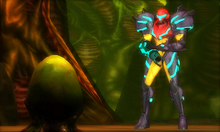
Samus finds a Metroid Egg in Metroid: Samus Returns.
An egg laid by the Queen Metroid. An Infant Metroid eventually hatches from it.
Infant Metroid[]
The infant has a simple body shape similar to a jellyfish. Perpetually floating in the air, the organism appears and behaves relatively docile, though it is known to be highly unpredictable at times and can attack without warning.
Metroid larva[]
A larva's physiology is mostly identical to an Infant's, however, its size has grown exponentially. Commonly seen as the face of the entire species, as it is the form most often encountered in the Metroid series. It is also the initial form given to the species by their Chozo creators. Seemingly unique to this stage and the previous Infant form are their responsiveness to Beta-Rays, which cause them to split and multiply within 24 hours. The larva and Infant stages can be grouped up together as the larval phase of a Metroid's life cycle.
Alpha Metroid[]
The Metroid is now visually akin to an arthropod, though its insect-like legs have not reached their full length and size, thus preventing their use for ground locomotion. It can discharge electricity as an offensive and defensive measure. Starting at this stage, the Metroid can no longer be entirely frozen in ice, but can nevertheless be wounded with the Ice Beam.
Gamma Metroid[]
This stage is an expansion to the prior form. The four legs have fully developed, allowing it to walk along the ground while still maintaining its ability to fly. Its mastery over electricity has augmented as well. The Gamma and Alpha stages can be categorized as a Metroid's pupal phase.
Zeta Metroid[]
The Metroid's body drastically transforms for a second time, and at this point shares many traits with that of a quadrupedal, theropod dinosaur. The Zeta Metroid can produce a variety of fire and plasma-based projectiles. It can no longer fly but possesses the highest level of agility in the entire Metroid life cycle.
Omega Metroid[]
The final and most powerful form of a standard Metroid. Now standing in a bipedal posture, the Omega Metroid sacrifices the mobility of the previous stage for increased size and strength, as well as gaining new attacks such as launching focused beams of fire. The Omegas and Zetas are together the adult phase of the species.
Evolved Metroids[]
In addition to the stages covered above, unknown circumstances can trigger the development of a rare, "evolved" variation of the Alpha, Gamma, Zeta, and Omega Metroids. The variants can be differentiated from the common counterparts by their orange pigmentation, an additional pair of eyes and the green coating on their backs resembling moss or fur with green veins spreading out on the edges. Their attacks are slightly altered and inflict more damage as well, thus making these evolved Metroids more powerful than the standard type. These variants are exclusive to Metroid: Samus Returns and are therefore not seen outside of SR388, including the planet's artificial replica.
Queen Metroid[]
The only form capable of laying Metroid Eggs. Only Metroids with specific genes can become Queens, however, it is unknown if they follow the same life cycle listed above. A Queen is quadrupedal and is the largest Metroid on SR388, surpassing the size and strength of even Omega Metroids, including their "evolved" variant.
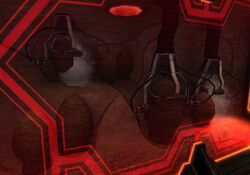
Metroid Eggs on the Pirate Homeworld.
Vulnerability[]
It has been established in various media and in-game sources, in particular Metroid Fusion, that the Metroids' major weakness is cold temperatures; merely placing them in a sub-zero environment is enough to either make them sluggish or cause them physical harm. A single projectile from a cold-based weapon such as the Ice Beam is sufficient to encase young Metroids in ice and only then can they be killed with concussive weaponry. Individuals that have matured beyond their larval form cannot be entirely frozen due to their developed tissue and exoskeletons, but can still be wounded with the Ice Beam if their mouths or their main weak-point, the translucent membranes, are targeted. Strangely, the membranes of older Metroids can be damaged with Missiles without freezing them, contrary to younger members of the species; this discrepancy may be tied to the fact that larvae carry more nuclei than later forms. Regardless, if Samus were to run out of ammo for her other weapons, the Ice Beam consistently remains her best option to survive a Metroid encounter. Aside from this, darkness-derived energy weapons seem to possess cold properties which makes them just as effective.
Their homeworld of SR388 seemingly does not possess any naturally-occurring, sub-zero climate, thus the species is capable of roaming every corner of the planet virtually unchallenged; some can be seen completely submerged in water while others have even made their homes within areas of extreme heat filled with lava. Though the Chozo laboratory in Area 7 of the planet features rooms covered with ice and snow, the artificial origin of the area strongly implies they are the result of temperature-controlled technology built by the bird-like race. Due to this lab being the very place where Metroids came into existence, it can be assumed that their weakness to the cold was intentionally implemented by their creators.
Aside from their weakness to cold, the Beam Burst which uses SR388's mysterious Aeion energy can harm Metroids that have grown past their larval form. Several entries in the series have also demonstrated that massive explosions capable of annihilating entire areas can destroy the creatures, but their high damage output makes them unconventional and inconvenient as they can cause unwanted casualties. Another highly dangerous method to killing them requires an individual to be swallowed alive by a sufficiently large Metroid to bypass the translucent membrane's protection, followed by detonating a few Bombs directly on the nucleus; to date, only Samus Aran has accomplished this and exclusively on Queen Metroids. In addition, a Metroid can theoretically be killed even by its prey, the X Parasites, should the latter combine enough genes from extremely powerful creatures they had infected.[note 1]
To a lesser extent, Metroid larvae, or at least the Tallon variant, also have problems processing solid meals, which is humorously implied by a Pirate Log on Aether banning treating the Metroids as pets, including the feeding of pet treats to them, with the act resulting in the Metroids showing symptoms comparable to food poisoning and making them a lot more dangerous.
Purpose[]
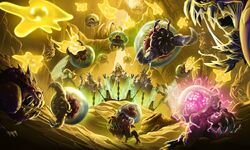
Several Metroid larvae attacking the X Parasites of SR388.
The Metroids were designed with the intention of preying upon the X Parasites, the original apex predators of SR388. Due to the reproductive capabilities of any individual X and its extreme lethal potential, it is likely the Thoha Chozo intended to render the former's rampant population extinct in order to preserve the planet's wildlife and secure the safety of their own civilization. As such, the Metroids are immune to the X's infection, allowing them to feed directly on the parasites' pure gelatinous forms. In addition, Metroids can acquire more strength and new abilities as they molt, such as generating electricity as well as launching acid and plasma-based projectiles, which are undoubtedly used against X Parasite hosts and their mimicries. Indeed, the Metroids were successful in lowering the population of their prey to the point that Samus Aran was able to safely explore SR388 without encountering a single X during her first visit.
Metroids have no trouble feeding on other lifeforms with the subsequent rarity of their main food source. Although they immediately established themselves as the new apex predators of SR388, the natural fauna and flora have greater chances of survival and better opportunities to flourish without the constant threat of the more dangerous X Parasites.
Impact on the Chozo[]
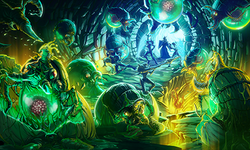
The Metroids start metamorphosing and attacking their creators, the Thoha Chozo.
The Chozo Memories in Metroid: Samus Returns reveal that the Metroids were at least partially responsible for the destruction of the Thoha Chozo civilization on SR388. Initially engineered to be pacifists toward the Thoha and hostile toward the X and Mawkin tribe, the once-tame artificial lifeforms molted beyond their larval stage and began to attack their creators and caused untold casualties. The impact was likely aggravated by the fact that Metroids were kept fairly close to the Thoha populace, akin to domesticated pets.
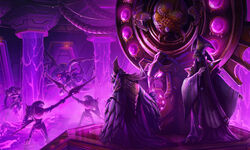
The Thoha flooding cavern with purple liquid to seal the Metroids underground.
Having lost their control, the Thoha overseers were forced to create the Chozo Seals that controlled the flow of the hazardous purple liquid throughout the cave systems, as seen in Memory 09. Upon releasing the substance on their own cities and flooding portions of the planet (bringing their civilization to a definitive end), the majority of the Metroids were successfully kept at bay underground, yet the Thoha could not stop their creations from thriving and propagating within their sealed homes. The few surviving Chozo of the Thoha tribe prepared to destroy the planet in the hopes of wiping out both the Metroids and the X, but were betrayed and executed on the planet's surface by the Chozo of the Mawkin tribe, as their leader Raven Beak wished to use the Metroids as weapons for galactic conquest.
At least two Metroid larvae remained on the planet's surface, where they were eventually discovered by offworld visitors.
Unnatural Metroid strains[]
Throughout the years of extensive research and experiments by Space Pirates, it was discovered that Metroid larvae are not only highly adaptive to planets outside of SR388, their biology is easily influenced by radiations as well.[4] As a result, the larvae are far more promising and exploitable as bioweapons than the later stages in the species' life cycle. This led to the creation of many unnatural Metroid breeds, and while there are some that turned out weaker than their original counterpart, many others became powerful aberrations. Their vulnerabilities vary greatly, though the cold remains somewhat prevalent. Interesting to note is that most of these unnatural strains were discovered long before the SR388 life cycle itself became known by the Galactic Federation.
The list below covers every single breed of Metroid in the entire series outside of the original SR388 strain.
Tallon Metroid[]

Samus encounters her very first Tallon Metroid in Metroid Prime Remastered.
A Metroid larva that adapted to the Phazon-tainted world of Tallon IV. Although its resilience was lowered significantly, it had near limitless potential for additional mutations.
Hunter Metroid[]
A Tallon Metroid that has further mutated on Tallon IV and developed a distorted body with tentacles.
Fission Metroid[]
A mutated Tallon Metroid that multiplies when damage is inflicted onto it.
Metroid Prime (Dark Samus)[]
A Metroid heavily mutated by a Phazon Core organism, as confirmed by the Metroid Prime Trilogy art booklet. Fully capable of reproduction. It later stole Samus Aran's Phazon Suit which contained her DNA and used it to become her doppelganger, granting it high sapience and the ability to use Chozo technology.
Infant Tallon Metroid (Metroid Cocoon)[]
An artificial strain created by Space Pirates. Intended to be used as organic portable batteries, they can also quickly grow into Tallon Metroids. Their cocoons are an artificial creation as well, used to sustain and carry large stocks of these infants.
Dark Tallon Metroid[]
A Tallon Metroid whose body is invaded and controlled by an Ing, rendering it more powerful and dangerous.
Phazon Metroid[]
The result of a Tallon Metroid heavily exposed to energized Phazon. This strain possesses a great number of unique abilities.
Miniroid[]
A mutated Infant Metroid born from an egg infused with Phazon. Miniroids can grow into Phazon Metroids.
Hopping Metroid[]
Another Phazon-induced Metroid that has acquired physiology akin to a Gamma Metroid's. In the Japanese version of Metroid Prime 3: Corruption, the similar Phazon Hopper is also a Metroid breed, described as the mature, reproductive form of the Hopping Metroid.
Metroid Hatcher[]
A tentacled, armored mutant, also exposed to Phazon. It is also capable of reproduction.
Mochtroid[]
These creatures are the first attempts made by the Space Pirates to produce clones of Metroids. They lack the physical strength and powerful defenses of a standard larva, and are thus regarded as failures.
Big Metroid[]
An anomalous, powerful stage reached by the last Metroid from SR388 when it was brought to planet Zebes. The cause for the abnormal growth is unknown, though it is likely a side effect of excessive Beta-Ray exposure. Giant Metroid larvae can also be created via the Amplification device.
Unfreezable Metroid[]
Metroid larvae genetically modified by the Galactic Federation to remove their main weakness to cold temperatures.
Samus Aran (Fusion Suit/Metroid Suit)[]
The heroine of the series became a Metroid hybrid on a genetic level after being injected with an experimental vaccine. The altered properties and the appearance of her Fusion Suit were partially the result of her DNA having combined with a Metroid's. Samus later gained the ability to siphon life energy and eventually the Metroid Suit which established her transformation into a full Metroid organism. Although her suit reverted back to normal when her Metroid genes were quelled, she seemingly remains a hybrid.
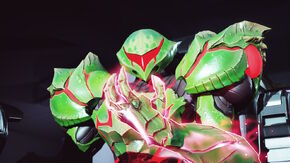
Samus, after becoming a Metroid.
Additional variants[]
There are a few Metroid breeds which possess very little differences from the strain they originate from.
- Zebesian Metroid: Larvae that have adapted to planet Zebes. They are nearly identical to the Metroid larvae from SR388, with the only dissimilarity being their acquired vulnerability to Power Bombs. They can also be temporarily repelled with a greater variety of weapons, including standard missiles, all Beam types and the Screw Attack. A scan in Metroid Prime 3 suggests that the Zebesian breed is more aggressive.[5]
- Aetherian Metroid: Tallon Metroids imported to planet Aether acquire red translucent membranes instead of the common green. No other difference is observed.
- Talvanian Metroid: All the Metroid Eggs and larvae on planet Talvania have been artificially enlarged with the Amplification beam by the Space Pirates. They do not possess any other noteworthy changes, however they are vulnerable to a large Mech's standard beam weapons while frozen.
- Xenomorph Metroid: These hostile holograms, based on Tallon Metroids and Mochtroids, are generated in training arenas where Samus practices her shooting skills.
- Biological Space Labs Metroid: The Metroid clones created in the research station's breeding program can rapidly grow through their natural life cycle in a matter of hours due to unclarified tampering by scientists. In addition, the resulting Omega Metroid cannot be hurt with Missiles. All specimens aboard the station are indistinguishable in appearance from their normal counterparts.
Non-canon strains[]
Non-canon warning: This article or section contains information that may not be considered an official part of the Metroid series in the overall storyline by Nintendo.
The following strains are featured in works that are not part of the official Metroid universe or were removed from it.
- Metroid: Alpha Type[6]: The Scan Visor's original designation of several Tallon Metroids in Research Lab Aether. They have no known difference from other Tallon Metroids and the name appears only in the original NTSC version of Metroid Prime.
- Metroid (Bonus Disc): A red Metroid seen on Aether. Classified as an "Alpha" strain of Metroid, though what this means is entirely unclear. This unused data only appears within the Metroid Prime 2: Echoes Bonus Disc and has since been updated with more accurate and canon information in the final game.
- Megaroid: An artificial strain in the Samus and Joey manga. Created by Space Pirates from the remains of a deceased Metroid.
- Metroid=Mutant: A specimen stolen by Space Pirates which mutated. Appears in Metroid: Zebes Invasion Order.
Non-canon warning: Non-canonical information ends here.
Miscellaneous traits[]
Several of the breeds observed throughout the series reveal additional information about the species as a whole. For instance, in addition to draining energy, Metroids can also heal other organisms by injecting them with life energy taken from prey as demonstrated in Metroid: Samus Returns and Super Metroid by the last surviving Metroid from SR388. The scan of a Tallon Metroid in Metroid Prime 2: Echoes states that the stored energy in a Metroid's body can be forcefully drained from it and used for various purposes, allowing the bioform to be used as a living rechargeable power cell. However, the same scan reveals that cellular breakdown can occur in the Metroid if its body is repeatedly drained. It is also revealed through the Pirate Homeworld scans in Metroid Prime 3: Corruption that Metroids have a sensitivity to certain sonic frequencies, which the Pirates exploited with tank barriers to subdue several Phazon Metroids in the Processing chamber.
One of the most interesting discoveries concerns a power rarely demonstrated by the species: their capacity to rob a prey's natural ability via consumption and, potentially, using the stolen ability afterwards. There are several confirmed instances of this power:
- When the Big Metroid removed the Mother Brain's Laser Brain Attack, though the former did not use the stolen ability and instead transferred it to Samus Aran.
- A more subtle demonstration was seen in the Metroid hybrid, Dark Samus, when she devoured Rundas, Ghor and Gandrayda, eventually using their attacks during her final battle on Phaaze.
There are two other events in which this ability-stealing power was possibly used by Metroid organisms, but is left ambiguous. The first involves the Metroid Prime being able to produce Phazon after supposedly devouring a Phazon Core. The second is Samus herself potentially demonstrating this power after becoming a Metroid hybrid, as she gains several abilities that naturally belonged to animals after she absorbs Core-X that were either mimicking or inhabiting those very same animals. An example is the Serris mimic's natural high speed becoming Samus's Speed Booster following her absorption of the creature.
History[]
Official data[]
Many of the pieces of data listed here only focus on the Metroid larva form or similar ones, not the entire species.
Metroid manual[]
- Metroid
- "This protoplasm in suspended animation was discovered on the planet SR388. It clings onto Samus' body and sucks his [sic] energy. It can't be destroyed directly with the normal beam. Freeze it with the ice beam, and then fire 5 missile blasts at it."
Virtual Console retranslation[]
- Metroid
- "This protoplasm, discovered on the planet SR388, clings to Samus and drains her energy. It can't be defeated with a normal beam, just repelled. Use a combination of the Ice Beam and missiles to defeat it."
The Official Nintendo Player's Guide[]
- METROID
- "This is a mysterious life form which was discovered on the planet SR388. It sticks to Samus’ body and sucks out his energy."
Nintendo Power Volume 29[]
- METROIDOLOGY
- "The Metroid are a race of semi-intelligent aliens controlled by the Mother Brain. They drain life energy from humans."
- METROID MANAGEMENT
- "The Metroids don't die easily. Two steps are required to defeat them. First, blast a Metroid with the Ice Beam, freezing it solid. Second, use five missiles to destroy it. Defeated Metroids leave behind super energy and missile refills that quickly replenish your stock."
Metroid II: Return of Samus manual[]
- METROID
- "This is their first shape after hatching from eggs. They will cling to any creature that they can find, drawing its victim's life energy away."
Metroid II: Return of Samus Virtual Console manual[]
- Metroid
- "This juvenile has just hatched from its egg and will cling to any creature it can find, drawing its victim's life energy away."
Super Metroid manual[]
- FLOATING LIFE FORMS - METROIDS
- "It is said that Metroids are life forms created by an ancient civilization. Metroids engulf living creatures and absorb their energy. They are very intelligent and quick to reproduce."
Super Metroid Nintendo Player's Guide[]

A Metroid larva in Super Metroid.
METROID
| Enemy Data | Description | |||||||
| Color | HP | ATK | E | BE | M | SM | PB | Tourian. Freeze them, then blast them with Super Missiles. |
| Normal | 500 | 120 | 10 | 20 | 35 | 20 | 12 | |
Information
Official Metroid Fusion website[]
"These energy-based creatures have the ability to absorb the life force from any living thing. As the natural predator of X-Parasites, however, the Metroid may now be the key to Samus's survival."
An energy-based life-form with a translucent, spherical upper body. Claw-like spikes protrude from the lower half of the creature, which it uses to latch onto its prey."
Metroid: Zero Mission manual[]
- Metroids
- "Metroids are the floating organisms discovered on the planet SR388. These fearsome predators latch onto other organisms and leech the life energy out of their prey."
Official Metroid: Zero Mission website[]
"SPECIMEN ID# M-1A
"Extremely dangerous! Gelatinous exterior of Metroid makes it impervious to beam weapons. Metroids can only be destroyed by Missiles while frozen. Large claws grip prey while smaller front fangs drain its life force. Transform to Morph Ball and use Bombs to escape grip. DANGER LEVEL: HIGH"
- "Gelatinous exterior"
- "Multiple brain stems"
- "Gripping claws" (Outer)
- "Energy-sapping fangs" (Inner)
Logbook entry[]
Metroid
Morphology: Metroid
Energy-based parasitic predator.
The dominant species of planet SR388, Metroids are energy-based parasitic predators. A Metroid will latch onto its prey and drain energy, growing larger as it does. The only way to shake an attached Metroid is to enter Morph Ball mode and lay a Bomb.
Metroid Prime and Metroid Fusion: Prima's Official Strategy Guide[]
- Metroid
- "Metroids are energy-sucking parasites that may not look like much, but present a serious threat. They're resistant to all weapons except for the Ice Beam. Expect to shoot them several times to destroy them. Once you have the Ice Beam, you can freeze them and then shatter them with a missile. If a Metroid attaches to you, enter Morph Ball mode and use a Morph Ball Bomb to shake the critter off. In cases where you enter a room containing both Metroids and Space Pirates, try freeing the Metroids and watch them lay waste to your common enemies."
- Metroid
- Found In: Phendrana Drifts, Phazon Mines, Impact Crater
- Recommended Weapon: Ice Beam, Morph Ball Bomb
- "Metroid are energy-based parasites that are averse to cold temperatures. A few shots from your Ice Beam are enough to destroy a Metroid. When a Metroid gets too close for comfort, it attaches to you and won't let go. The only way to escape is to go into Morph Ball mode and lay a Morph Ball Bomb. You can destroy an entire horde of Metroids with a single Power Bomb if the situation calls for it."
Metroid Prime: The Official Nintendo Player's Guide[]
- METROID
- "Samus thought she had eliminated the Metroid scourge from the galaxy, but they still live. The Metroid is a fierce, aggressive parasite that latches on to its victims and sucks out their life energy--growing larger and more powerful in the process. They are tenacious creatures and very difficult to take down. Their only weakness is an aversion to cold, which means the Ice Beam is your weapon of choice."
- SHUCK AND JIVE
- "The Metroid will break free of its container and attack you as soon as you get too close. Keep a lock on it, but be ready to dash out of the way. As soon as you see the creature back up and shake, it's about to charge. Dodge to one side or the other to avoid the strike."
- CHARGE BEAM, AWAY!
- "Until you get the Ice Beam, you'll have to use the Charge Beam to eliminate Metroids. Wait for it to attack and miss, then quickly lock on and unleash a Charge Beam blast. The Metroid is vulnerable for only a moment, so you may have to try a few times before you're successful. The Super Missile is also very effective."
- METROIDS SUCK
- "Sometimes you won't be able to avoid a Metroid attack. The only way to stop a Metroid that has latched onto you is to roll into Morph Ball form and drop a Bomb. The creature will be vulnerable for the first few seconds after the Bomb explodes, so try to charge your Power Beam and take it out before it recovers."
Metroid Prime Official Strategy Guide[]
- METROID
- MORPHOLOGY
- "Metroids are energy-based parasitic predators. The dominant species of planet SR388, Metroids can such the life force out of living things. A Metroid latches onto its prey and drains energy, growing larger as it does. The only way to shake an attached Metroid is to enter Morph Ball mode and lay a Bomb."
- COMBAT TIPS
- "These are the original type of Metroids which are made of energy. The creatures try to latch on to Samus's visor, and if successful, escape by going into Morph Ball mode. Metroids can be destroyed with any weapon, but increase in size when hit with energy-based weapons such as the Power Beam and Charge Beam. The best way to destroy a Metroid is to freeze it with the Ice Beam and shatter it with a Missile."
Metroid Prime Official Perfect Guide[]
- METROID
- "Metroids are as fast as they've always been--very fast. If they clamp onto you they'll start sucking your life away--roll up into a Morph Ball and bomb your way to safety if this happens. Use whatever weapon's to your liking to destroy them."
Official Metroid Prime Website[]
"Metroids are highly dangerous parasites averse to cold temperatures. The dominant species of planet SR388, Metroids can suck the life force out of living things. A Metroid will latch onto its prey and drain energy, growing larger as it does.
Metroid Prime Pinball manual[]
"An energy based, highly dangerous parasite."
Smash Tips[]
"These alien creatures float around and then try to clamp down on you with their sharp fangs. Quickly struggle to break free from their grasp."
Smash Tour (SSB4 Official Game Guide)[]
"Lasts 5 turns or until a player bumps into it two times"
"Bumping into this enemy costs you several stat boosts! Reclaim lost stat boosts by bumping into it a second time."
Dedicated terminal (M17: Infestation)[]
Pirate Log: Metroids
There is an extreme danger in handling Metroids. In case of a loss of containment, immediately freeze and secure specimen(s).
Nintendo Australia and New Zealand tweet[]
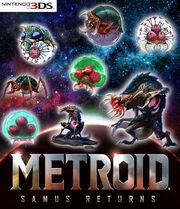
"On the eighth day of Christmas, Nintendo gave to me:
Eight Metroids growing…"[7]
Metroid Dread Report, Volume 3: Seven Points That Define the 2D Saga[]
- 2. Metroid
- "This enigmatic, floating life form has the terrifying ability to attach onto other organisms and absorb their energy.
- Originally, the Metroid were artificially created by the Chozo—an intelligent species with a vision for galactic harmony—to destroy the dangerous X parasitical life form found on planet SR388.
- Some have tried to weaponize Metroids because of their energy-absorbing ability, which has made this species the source of several conflicts in the past.
- Samus was sent to planet SR388 by the Galactic Federation on a mission to eradicate the Metroid. She successfully accomplished her mission and returned with a Metroid hatchling in tow. As Samus was the first creature the hatchling saw, the “baby Metroid” imprinted onto her and believed Samus to be its mother. Soon after, however, this Metroid would become a source of conflict with the Space Pirates. In an ensuing battle, this Metroid would bravely sacrifice itself to save Samus. The species would go completely extinct after one of Samus’s later missions."
- ~Transmission from the dev team~
- "You may not know if you haven’t played the series before, but this character that looks like a jellyfish is the titular “Metroid.” I’m sure some of you may have thought that the character Samus was named Metroid?
- The name “Metroid” comes from the Chozo word meaning “ultimate warrior.”
- While the Metroids have already gone extinct by the time of the events of the Metroid Dread game, it could be fun to speculate about what role they play in this adventure."
Nintendo tweets[]
- Nintendo of America
- "The floating entities known as Metroids have the ability to absorb energy from other organisms. They were created by the Chozo to defeat the X Parasite on Planet SR388.
- Since then, some have tried to weaponize this creature, leading to several conflicts. #MetroidDread"[8]
- "During the events of Metroid II and Super Metroid, a young baby Metroid imprinted itself upon Samus Aran, considering her its mother. It later bravely sacrificed itself to save Samus.
- At the time of Metroid Dread, the Metroids no longer exist. http://ninten.do/6019nefmt"[9]
- Nintendo UK
- "Created by the Chozo and once targeted for weaponisation by the Space Pirates, the Metroids have long been in Samus's sights. That is, until they went extinct...
- #MetroidDread"[10]
Metroid.nintendo.com[]

- METROID
- "This enigmatic, floating lifeform was artificially created by the Chozo to destroy the dangerous X parasite found on planet SR388. Now extinct, the Metroid could attach onto other organisms and absorb their energy."
Appearances in other media[]
Non-canon warning: This article or section contains information that may not be considered an official part of the Metroid series in the overall storyline by Nintendo.
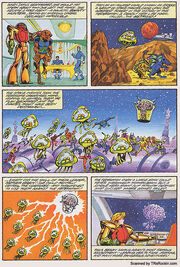
Metroids as they appear in the Nintendo Comics System
- Metroid larvae appear in the Kid Icarus franchise, under the name Komayto, which is stated in the instruction manual to have come from another planet. This creature can be found flying around Skyworld in packs. Kid Icarus was also created using the Metroid game engine. During the game Kid Icarus: Uprising, the main character Pit states himself that "Komaytos kind of look like little Metroids" before being hushed by Viridi.
- A Metroid larva (albeit with a blue coloring) is a collectible treasure from "Story 4: Don't shock the owl!" of "Final Chapter: Mysterious Factory!" in the Game Boy and Game Boy Color game Wario Land II. They are also often in 9-Volt's microgames in the WarioWare series, such as WarioWare, Inc.: Mega Microgame$!, WarioWare, Inc.: Mega Party Game$!, WarioWare: Touched! and WarioWare: Twisted!.
- Metroid larvae made an appearance in Kirby's Dream Land 3 for the SNES. If Kirby freezes all the Metroids in the level, Samus removes her helmet and gives Kirby a Heart Star. Interestingly, Kirby is completely immune to their life draining abilities when they try to attack him.
- Metroid larvae wander onto stages randomly in Metroid Prime Pinball and also have their own minigame, Metroid Mania.
- In Metroid Prime 3: Corruption, a Metroid is used on the tab for the creatures section of the Logbook. Interesting to note is that the Metroid depicted here has six nuclei, five encircling the top of a larger, centralized nucleus.
- The baby from Metroid II: Return of Samus and Super Metroid appears as an item in the Nintendo DS game Animal Crossing: Wild World. It appears in its signature capsule, and if tapped will play a few seconds of the Super Metroid title screen theme. It is a rare item that is acquired randomly by shooting down Gulliver. The item also appears in Animal Crossing: City Folk, but cannot be transferred through the ingame catalog due to the item's rarity. It acts the same way as before and is obtained in the same manner as well; it will play the entire Super Metroid theme this time, however. The same item appears once again in Animal Crossing: New Leaf, but it is not obtained through the same method as the two previous games. Instead, it is randomly acquired through fortune cookies, which the player can buy using two of the 3DS's Play Coins. This version also plays only a few seconds of the title theme.
- In Tetris DS, there is a single player game mode called Catch Mode where players catch Tetrominoes (blocks) in order to create a 4X4 square and detonating it to make the cluster smaller. The Brinstar theme plays during this and encapsulated Metroids (in capsules similar to the Metroid hatchling's) fall down. If touched, the energy meter will go down and the cluster becomes smaller.
- A Tallon Metroid (simply called a Metroid) can be seen on Nintendo Monopoly representing St. James Place for $180.
- A Metroid larva is shown in a capsule in Singularity along with the message "Mother my brain hurts."
- A Metroid larva is seen in a tank in Starcraft 2: Wings of Liberty in the secret Mission "Piercing the Shroud." It is very similar to that of the baby.
- The Retro Studios-developed Donkey Kong Country: Tropical Freeze contains an appearance by a Metroid larva as an Easter egg in level 4-3, Amiss Abyss. To access it, the player must swim through a tunnel about midway through the level, then swim back the way they came and pass through a cluster of electrified anemone tentacles that closed behind them initially, taking damage in the process. This causes a small school of fish in the background to swim upwards into view, followed shortly thereafter by the Metroid.[11] Retro most likely chose this level to house the Metroid cameo because it features a wide variety of bioluminescent undersea life, among them jellyfish; the Metroid even swims through the water by undulating its talons in the same manner as a jellyfish does with its tentacles. This secret went undocumented for nearly four-and-a-half years.[12]
Super Smash Bros series[]
Metroid larvae appear in a minor reference in Super Smash Bros., in Super Smash Bros. Melee as a trophy as well as the baby being seen in the opening cutscene, and in Super Smash Bros. Brawl, Super Smash Bros. for Nintendo 3DS and Wii U and Super Smash Bros. Ultimate as an Assist Trophy that will latch onto opponents and "drain" them of energy.
What they actually do is increase the victim's damage, but they can still sap health if a stamina match is being played. It can be shaken off, which will cause it to try and seek another victim. It can phase through platforms similar to a Phazon Metroid. Using Up-Special moves while the Metroid is latched on to a character cancels the move after the few starting frames; this can be done multiple times in a row. This allows some characters to stay in the air for quite a while. In Ultimate, the Metroid can be frozen with any freezing items or moves (such as Lucas's PK Freeze), and then attacked to destroy it.[13]
Interestingly, the model of a larval Metroid used in-game for the Nintendo 3DS and Wii U games exhibits unnaturally large inner-fangs; in fact, they appear to be larger than the outer ones. In Melee, the intro scene from Super Metroid is reflected off of the trophy, with the infant missing from the scene.
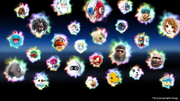
A Metroid also acts as one of many Spirit characters in the game, which can be equipped to any character and fight alongside them. Its artwork is taken from Metroid: Samus Returns.
Super Smash Bros.[]
Metroids are briefly mentioned in Samus's "Characters" bio in the "Data" section of Super Smash Bros.. Her bio says that Samus "...pursues the airborne life form, Metroid, throughout the whole universe."
Super Smash Bros. Melee[]
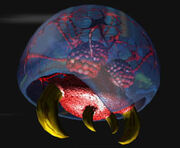
Super Smash Bros. Melee website.
"A parasitic life form that can absorb all types of energy, Metroids have strong resistance to most conventional weaponry. To defeat them, Samus Aran had to freeze them with Ice Beam shots and then blast them with missiles. Mochtroids, which look like Metroids, are weaker, with fewer internal nuclei."
(Metroid 08/89).
Super Smash Bros. Brawl[]
"A bioengineered life-form found on planet SR388. Metroids attach to organisms and drain life energy. The Galactic Federation commissions Samus to eliminate them, but Space Pirates try to harness their power. One of the few ways Samus can kill Metroids is by shooting them with the Ice Beam and then shattering them with missiles. The Metroid's cry is chilling and indescribable."
Metroid (1987)
Metroid II: Return of Samus (1991)
Smash Bros. DOJO!! data on the Assist Trophy[]
"Like the name says, this Assist Trophy is from the game Metroid. It's an artificial life-form that absorbs all kinds of energy.
In our game, it also attaches to the head and starts to drain its victim. Since it will increase your damage, try to shake it loose."
Stickers[]
- Metroid Metroid Prime Pinball - [Freezing] Attack +18 (All)
- Metroid Metroid: Zero Mission - [Electric] Attack +20 (Samus, Zero Suit Samus)
Super Smash Bros. for Nintendo 3DS and Wii U[]
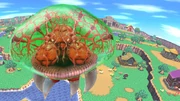
Super Smash Bros. for Nintendo 3DS and Wii U Trophy[]
- NTSC
- "First discovered on planet SR388, this floating life-form grows by absorbing the energy around it. It is incredibly durable but extremely weak to cold. In Smash Bros., a Metroid will grab a rival by the head and drain energy. If you get grabbed, shake it off by pressing left and right!"
- PAL
- "Mysterious floating life-forms, discovered on the planet SR388, that absorb energy from other living beings. They're tough, except when they're cold. In this game, they'll try to attach themselves to fighters' heads and drain their energy. Press all the buttons you can to shake them off!"
Super Smash Bros. Ultimate[]
Assist Trophy description[]
"Latches on to an opponent and steals their energy. It can be killed if frozen."
Nintendo Land[]
Metroid larvae appear as robots. They can suck out the Mii's energy but they also like to drop Miis in the Lava on the volcano map. Metroids must be frozen with the Ice Charge before shooting their core to kill them, reminiscent of how they are killed in the official Metroid games. This game also implies that the Chozo went extinct because they lost control of the Metroids.
Non-canon warning: Non-canonical information ends here.
Etymology[]
Hiroji Kiyotake: There was one more staff member, and the two of us decided on it. We attached "android" to the "metro subway" and that's how we got "Metroid". [14][15]
Trivia[]

The origin of the Metroids.
- Metroids are repeatedly referred to as “parasites” throughout the games; however, they would be more accurately described as predators.
- Samus Aran eventually becomes a Metroid hybrid akin to her doppelgänger Dark Samus, who also possessed both human and Metroid DNA. Though her previous genetic makeup was presumed to be restored after absorbing the core of the SA-X, the opening scenes of Metroid Dread confirm this is not the case.
- Chronologically, Samus' first encounter with Metroids occurred in Tourian; ironically, the last of the species would later become extinct there.
- While the Metroids' purpose was stated in the manual for Metroid Fusion and heavily hinted at in the Chozo Memories from Metroid: Samus Returns to be the eradication of the X Parasites, the backstory in the PAL Super Metroid Players' Guide tells a different story. It states that the Metroids may have been given their ability to transfer energy into organisms by their creators with the hope that the creatures could use it to benefit humanity.
- Bioforms that are killed by Metroids turn into husks with characteristics that, for unknown reasons, vary during time. Some turn into an extremely fragile brown or colorless husk that crumbles into dust on contact, while others become hardened corpses that cannot crumble.
- Metroids have never been successfully contained without them breaking free sooner or later, either through their own means or through the help of another being, intentional or not.
- Additionally, it is arguable that Mother Brain's telepathic powers were unable to maintain complete dominance over Metroids, as a few varied incidents in the past have provided some skepticism to the level of control Mother Brain has had on the creatures.
- There have been no known cases of intraspecific competition between Metroids for the right to feed. In occasions where several Metroids are in the presence of a potential prey, they will take turns attacking the victim (in the Prime series as well as Zero Mission, Samus Returns, and Other M gameplay), or will group together to feed on a victim simultaneously (as seen in Metroid, Metroid II, Super Metroid and during a cutscene in Zero Mission).
- Dark Tallon Metroids were seen piling Pirate Troopers together in the Phazon Grounds on Dark Aether, seemingly conserving their food for later group feedings. However, this behavior is most likely non-existent in other Metroid variants, as these Dark Tallon Metroids are actually controlled by the sapient race known as the Ing. Ing, specifically Warrior Ing, have been shown to display such behavior, as seen in their introductory cutscene when multiple Ing - which would later become the Sub-Guardians that possess Samus's stolen gear - attack Samus all at once.
- A Metroid project "Dread" is mentioned in a scan in Metroid Processing detailing failed Pirate plans to use Metroids as a battery source, although many fans assumed it was a reference to Metroid Dread, a canceled game for the Nintendo DS that was revived in 2021 for the Nintendo Switch.
- The full limitations of Metroid behavior has not fully been explored. However, it may extend beyond the simple feeding instinct, as demonstrated by the baby in Super Metroid. Technically, it had grown beyond the imprinting of Samus as its mother, yet it still recognized her and restrained itself, even going so far as to save her from Mother Brain and transfer energy and a new weapon back to her.
- Ironically, the Galactic Federation has been successful in many elements concerning the Metroids, many of which the Space Pirates ultimately failed to achieve despite years of trial and error. The ringleaders had found an extremely reliable way of controlling Metroids in the form of the humanoid MB. They had also successfully rid the creatures of their greatest vulnerability: cold. Finally, the Federation was able to give the Metroids access to the rest of their life cycle, despite the creatures being located outside of their homeworld, SR388.
- The Metroids have actually been able to nullify their weakness to cold on one occasion, long before the Federation did. This was seen in specific Fission Metroid variants and Metroid Prime's core form during Samus's mission on Tallon IV. However, this invulnerability was unintentional, as these two Metroid species had achieved this ability through an unpredictable series of mutations caused by Phazon.
- Metroids seem to not have the need to breathe oxygen. This is seen when entering the G.F.S. Valhalla; while exploring the destroyed ship, Metroids are seen outside of the ship and wandering about in space. Also, an Omega Metroid was in the hangar bay of the Biologic Space Laboratories research station, as the door was broken showing the vacuum of space, possibly having the room decompressing.
- In Metroid Prime, Metroids who have broken free from their containment tubes will engage in combat with the Pirates and vice versa. However, on the Pirate Homeworld in Metroid Prime 3: Corruption, both sides will ignore each other and assault Samus in tandem. A logical explanation would be that both sides, being corrupted by Phazon, no longer see each other as adversaries (this has been noted in Pirate research experiment reports found by Samus in Metroid Prime) or that both species are forced by Dark Samus to work as a group. This could also be due to a programming error, as both creatures never appear in the same room outside of containment unless Samus trips the alarm and enters a Metroid-infested room, forcing the Pirates to appear in it.
- In Metroid Prime and Metroid Prime 2: Echoes, when a Metroid collides with Phazon or an open door, it will explode.
- The Blue X of Metroid Fusion attempted to counteract against Samus due to her Metroid cells and her weakness to cold. It is doubtful Cold X existed back on SR388 due to the planet's lack of a natural cold climate. If they had existed, it is possible the Blue X would have had an advantage over the Metroids on SR388.
- In early encounters with the SA-X, the imitation would attempt to kill Samus by using the traditional tactic used to kill larval Metroids (freezing her in place with the Ice Beam, then shooting a Super Missile at her).
- Some Space Pirates are known to have treated Metroids as pets. Although High Command strictly forbids this, some Metroids can be scanned with evidence of being recently fed with Space Pirate rations and pet treats. This caused the Metroids in question to suffer food poisoning and occasionally became frenzied creatures.
- Metroids are the series' equivalent to the titular Aliens (Xenomorphs) of the Alien series, featuring a life cycle, a Queen producing eggs and being a menace to the female protagonist. Additionally, the first movie implied a connection between the Space Jockey's race and the Xenomorphs, leading to theories of the former being involved in the creation of the latter, similar to how the Chozo were connected to their Metroids.
- The Zeta Metroids secreting the previously mentioned yellow mucus from its mouth is another parallel to the Xenomorphs, as both organisms use their hardening saliva to form their nests.
- A Metroid appears in the Piercing the Shroud level of Starcraft II: Wings of Liberty, in a capsule similar to the baby's.

Note the four nuclei visible within the blue inset.
- The background of Metroid Prime Pinball's Wireless Mission mode features a Metroid with many more, smaller nuclei and a jagged shell.
- When reading the temporary scan of a creature in Corruption, a pair of Metroids are seen to either side of the scan's text. The nuclei of the two Metroids are placed side to side and are connected by lines to the bottom of their membrane.
- NES Remix includes a Metroid Miiverse stamp.
- Phazon was originally explained as the remaining energy from the Metroids Samus exterminated on Zebes, undergoing fractal cloning. An image of it can be seen here
- Despite their weakness to cold temperatures, Metroids can survive in space, which constantly fluctuates between extreme heat and extreme cold.
- In the original Metroid, besides the traditional green-colored Metroids with red nuclei, there were also red-colored Metroids that specifically target Samus (the traditional green ones simply float around). They were omitted from the remake Metroid: Zero Mission, although the red Fission Metroid and Tallon Metroid display similar physical features to the aforementioned red Metroids.
- Metroid: Samus Returns Official Guide strangely claims that the Chozo had discovered Metroids living on SR388 as opposed to creating them, contradicting lore established in Super Metroid and Metroid Fusion as well as image 5/11 of the Chozo Memories which displays their apparent creation as a means to counter the X Parasite.
- The real-life etymology of the word "Metroid" is a portmanteau of "Metro" and "Android", but within the canon of the Metroid series, it is stated to be the Chozo term for "ultimate warrior".
- Quiet Robe and Raven Beak pronounce Metroid as /maθɾoi̯ð/ instead of /mɛtɹɔɪd/, although its spelling remains unchanged in the written Chozo language.[16]
Gallery[]
For official artwork, see Metroids' Gallery.
Original Metroid art for a Metroid larva. Metroid Egg in the original Metroid 2 Infant Metroid in the original Metroid 2 Metroid larva in the original Metroid 2 Alpha Metroid in the original Metroid 2 Gamma Metroid in the original Metroid 2 Zeta Metroid in the original Metroid 2 Omega Metroid in the original Metroid 2 Queen Metroid in the original Metroid 2 A Queen Metroid, the eight and final stage in the Metroid life cycle, only reached by special individuals. A Metroid seen during a video screen, where Galactic Federation scientists explain to Samus about the Metroid Vaccine. Metroid: Zero Mission. Notably, these Metroids possess flashing bodies and pulses of lightning around their membranes. BR5497, the first Tallon Metroid encountered in Metroid Prime. Nintendo of America tweet asking if fans would rather have Yoshi, a Metroid, or Pikmin as a pet.[17] Max Factory figure |
Notes[]
- ^ This is implied by the game over that occurs if the player lets Raven Beak X come close to them, where the creature consumes and presumably kills Samus despite the latter adopting the Metroid Suit at that time.
References[]
- ^ Metroid Dread Report, Volume 3: Seven Points That Define the 2D Saga
- ^ Wikipedia:bioweapon Metroid Prime Pirate Data "Metroid Morphology" from Phendrana Drifts
- ^ "Scans indicate that this hostile environment has produced a new mutation in the Metroid genome: the ability to evolve into progressively larger, and more deadly forms." -- SR388 Data File [1]
- ^ Space Pirate Data: Observations on Metroids native to different planets display subtle variations in biological processes. Our Homeworld's atmosphere has resulted in various unique physiological mutations.
- ^ Data decoded. Zebes specimen.
Highly aggressive subject has been
transferred to an off-site laboratory. - ^ This high energy lifeform is a Metroid: Alpha Type (Scan in Metroid Prime, NTSC version only)
- ^ Nintendo Australia and New Zealand (NintendoAUNZ). 20 Dec 2017, 5:00 a.m. Tweet. https://twitter.com/NintendoAUNZ/status/943405638033592320
- ^ Nintendo of America (NintendoAmerica). 19 July 2021 3:00 p.m. Tweet. https://twitter.com/NintendoAmerica/status/1417197554618540033
- ^ Nintendo of America (NintendoAmerica). 19 July 2021 3:00 p.m. Tweet. https://twitter.com/NintendoAmerica/status/1417197564257095681
- ^ Nintendo UK (NintendoUK). 20 July 2021 9:00 a.m. Tweet. https://twitter.com/NintendoUK/status/1417469426929217543
- ^ Shane Marchis on Twitter: "Here's a how-to video on seeing the Metroid cameo I discovered earlier. Works on Wii U and Switch!". Retrieved on July 4, 2018.
- ^ Gach, Ethan. Four Years Later, Players Found A Metroid Hidden In Donkey Kong: Tropical Freeze. Kotaku. Retrieved on July 4, 2018.
- ^ https://www.youtube.com/watch?v=5ynj8-yBqew
- ^ Famicom Disk System: The More You Play It, the More You'll Want to Play!. Metroid Database. Archived from the original on 2023-03-22. Retrieved on 2024-01-31.
- ^ Nintendo of America (NintendoAmerica). "Fun fact: the game’s title comes from a combination of the words ‘metro’ and ‘android’." 6 August 2021 9:30 a.m. Tweet. https://twitter.com/NintendoAmerica/status/1423637515605532673
- ^ Transcripts from E.M.M.I. Reactivated Cutscene
- ^ Nintendo of America (Nintendo America). "Yoshi? Metroid? Pikmin? If you could have any Nintendo creature as a pet, who would it be?" 25 January 2015 1:30 p.m. Tweet. https://twitter.com/nintendoamerica/status/559417926043045888
| Bioweapons | |
|---|---|
| Space Pirates | Bombu • Class I Energy Harvester • Elite Pirate • Megaroid • Metroids • Mimic • Omega Pirate • Phazon Elite • Preed • Puffer Mine |
| Galactic Federation | Cyborg Zebesian • Nightmare • Queen Metroid • Super Zebesian • Unfreezable Metroid • X Parasite (desired) • SA-X (desired) |
| Other | Kanden • Quadtroid |
| Related | Bioweapon Research Center • Project Metroid Warriors •Special-forces unit |


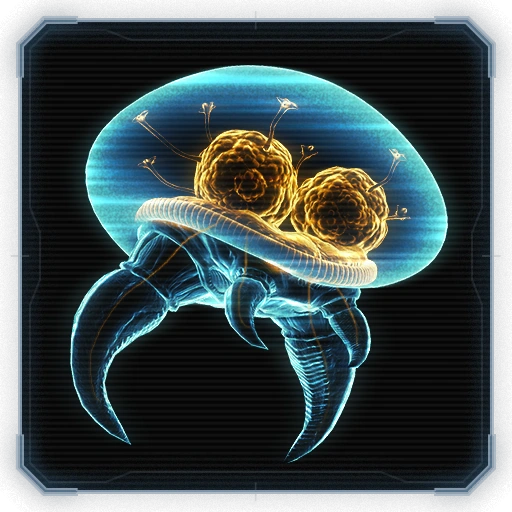
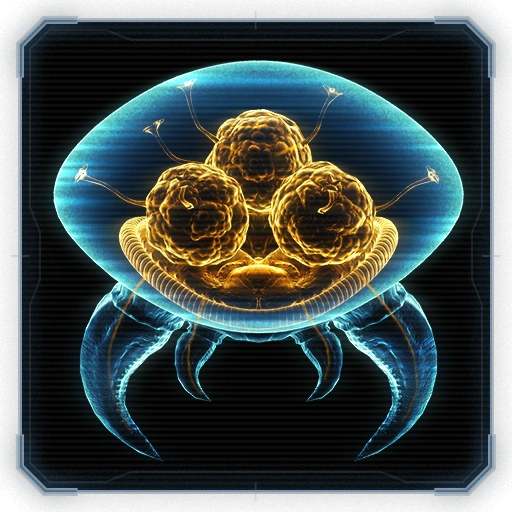
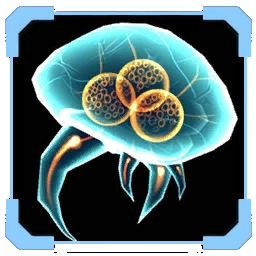
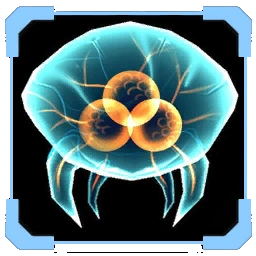
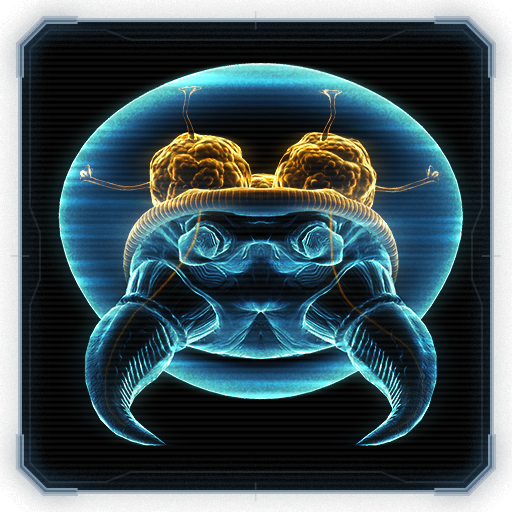
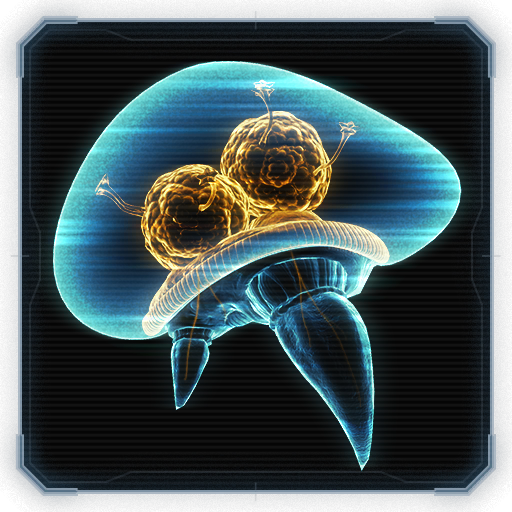
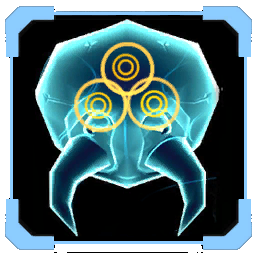
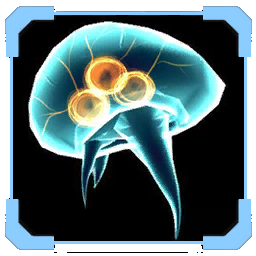
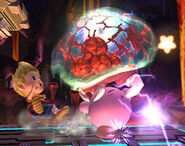
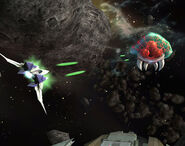
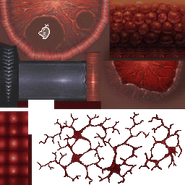

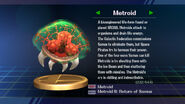
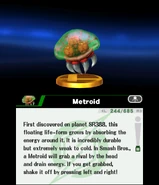
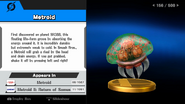
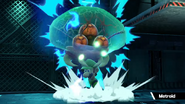
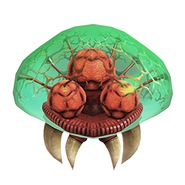
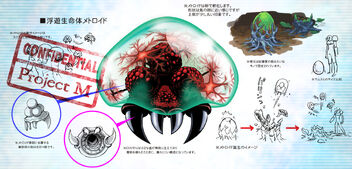









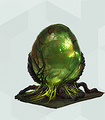

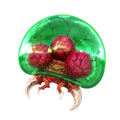
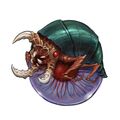


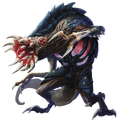









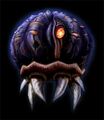




![NOA tweet about pets.png (337 KB) Nintendo of America tweet asking if fans would rather have Yoshi, a Metroid, or Pikmin as a pet.[17]](https://static.wikia.nocookie.net/metroid/images/c/ce/NOA_tweet_about_pets.png/revision/latest/scale-to-width-down/90?cb=20190921202703)

